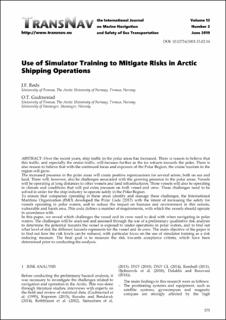| dc.contributor.author | Røds, Johan-Fredrik | |
| dc.contributor.author | Gudmestad, Ove Tobias | |
| dc.coverage.spatial | Arctic | en_US |
| dc.date.accessioned | 2021-04-12T09:25:25Z | |
| dc.date.available | 2021-04-12T09:25:25Z | |
| dc.date.created | 2019-09-06T11:16:15Z | |
| dc.date.issued | 2019 | |
| dc.identifier.citation | Røds, J.F., Gudmestad, O.T. (2019) Use of simulator training to mitigate risks in arctic shipping operations. TransNav, International Journal on Marine Navigation and Safety of Sea Transportation, 13 (2), 375-379. | en_US |
| dc.identifier.issn | 2083-6473 | |
| dc.identifier.uri | https://hdl.handle.net/11250/2737255 | |
| dc.description.abstract | Over the recent years, ship traffic in the polar areas has increased. There is reason to believe that this traffic, and especially the cruise traffic, will increase further as the ice retracts towards the poles. There is also reason to believe that with the continued focus and exposure of the Polar Region, the cruise tourism to the region will grow. The increased presence in the polar areas will create positive repercussions for several actors, both on sea and land. There will, however, also be challenges associated with the growing presence in the polar areas. Vessels will be operating at long distances to other vessels and land infrastructures. These vessels will also be operating in climate and conditions that will put extra pressure on both vessel and crew. These challenges need to be solved in order for the ship industry to operate safely in the Polar Region. To ensure that companies operating in these areas identify and manage these challenges, the International Maritime Organization (IMO) developed the Polar Code (2017) with the intent of increasing the safety for vessels operating in polar waters, and to reduce the impact on humans and environment in this remote, vulnerable and harsh area. This code defines a number of requirements, with which the vessels should operate in accordance with. In this paper, we reveal which challenges the vessel and its crew need to deal with when navigating in polar waters. The challenges will be analysed and assessed through the use of a preliminary qualitative risk analysis to determine the potential hazards the vessel is exposed to under operations in polar waters, and to find out what level of risk the different hazards represents for the vessel and its crew. The main objective of the paper is to find out how the risk levels can be reduced, with particular focus on the use of simulator training as a risk reducing measure. The final goal is to measure the risk towards acceptance criteria, which have been determined prior to conducting the analysis. | en_US |
| dc.language.iso | eng | en_US |
| dc.publisher | Gdynia Maritime University | en_US |
| dc.rights | Navngivelse-Ikkekommersiell 4.0 Internasjonal | * |
| dc.rights.uri | http://creativecommons.org/licenses/by-nc/4.0/deed.no | * |
| dc.subject | shipping | en_US |
| dc.subject | risikostyring | en_US |
| dc.subject | simuleringsbasert trening | en_US |
| dc.subject | polarområder | en_US |
| dc.subject | Arktis | en_US |
| dc.title | Use of simulator training to mitigate risks in arctic shipping operations | en_US |
| dc.type | Peer reviewed | en_US |
| dc.type | Journal article | en_US |
| dc.description.version | publishedVersion | en_US |
| dc.subject.nsi | VDP::Teknologi: 500::Marin teknologi: 580 | en_US |
| dc.source.pagenumber | 375-379 | en_US |
| dc.source.volume | 13 | en_US |
| dc.source.journal | TransNav, International Journal on Marine Navigation and Safety of Sea Transportation | en_US |
| dc.source.issue | 2 | en_US |
| dc.identifier.doi | 10.12716/1001.13.02.14 | |
| dc.identifier.cristin | 1722224 | |
| cristin.unitcode | 217,8,5,0 | |
| cristin.unitname | Institutt for maskin, bygg og materialteknologi | |
| cristin.ispublished | true | |
| cristin.fulltext | original | |
| cristin.qualitycode | 1 | |

